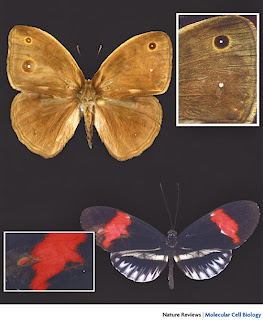This week’s lectures and resources opened the doors into the
world of Biotechnology and it’s connection with Art. Artists have entered into
the scientific field and brought with them their creativity to construct and
design art while using living organisms as their main subject. One artist in
particular, Eduardo Kac is known for the genetic manipulation of a rabbit’s DNA
by inserting a “GFP” gene that allowed the cells to produce “Green Fluorescent
Protein”. This albino bunny named “Alba” is a living creature that can also be
considered a form of art. When a black light is turned on, Alba begins to glow
as she emits a fluorescent light from her body. Professor Vesna explains that
this form of art known as “Transgenic Art” has stirred the pot and is one that has
become very controversial as it, “transfers natural or synthetic genes to
create unique living beings” (Vesna). The issue arises whether or not these artists who
create or manipulate living organisms should have separate standards, which is
a question posed by Ruth West. Artists, who use the form of Transgenic Art,
push the boundaries attempting to do something that has never been done and
because of this they find themselves in a difficult position that ultimately
questions their morals and intentions.
As artists enter into the scientific labs and go hands on
with living organisms they alter the
natural blueprints of organisms to create what they consider art, which is
known as BioArt. Professor Vesna explains how the artist Marta de Menezes
created her artwork by modifying the wing patterns of butterflies. She began by diving into the basic structure of the butterfly and from there she could design the
patterns on the wings. However, this became very controversial due to the fact
that she was modifying the natural development of the patterns on the
butterflies wings. When the butterflies were put on display the public saw that the butterflies in fact had holes in their wings and were very upset over this. This relates to the question posed by Ruth West on the
standards that should be set for artists who are manipulating living organisms.
As these artists intend to create and construct pieces of art that illustrate
the beauty and power of the scientific world, the opposing view sees this
connection between biotechnology and art as potentially dangerous and
threatening to living species.
 |
| Image 2: Marta de Menezes's modifying butterfly wing patterns |
Kathy High is an artist who illustrates how the use of
living organisms can be beneficial for scientific research. Professor Vesna
explains how Kathy High uses Transgenic Rats that are specifically engineered
for scientific research. She explains that the reason she has these rats on display
is to, “extend their observation of humans and to extend their lives”
(Embracing Animal). Although the rats have been altered using biotechnology and
put on display for the public to watch, by doing this Kathy High has been able
to open the eyes of many to see how these rats are very similar to human
beings and should be viewed differently than as "pests". By treating the rats with great care and providing them with necessary
treatment, it helps show how the connection between Biotechnology and art can
also lessen the controversy over manipulating living organisms.
 |
| Image 3: Kathy High with the Transgenic Rats |
SOURCES:
Vesna, Victoria. Lectures Week 6.
Image 1. "BIO ART." BIO
ART. Web. 09 Nov. 2013. http://www.ekac.org/gfpbunny.html
Image 2. Nature.com. Nature Publishing Group,
Web. 09 Nov. 2013. http://www.nature.com/nrm/journal/v10/n7/fig_tab/nrm2699_F2.html
Kathy High. Embracing Animal. http://www.embracinganimal.com/ratlove.html

I like your interpretation and expansion on Professor Vesna's lectures. I was going to do the genetically modified rabbits as well. This week is an interesting topic.
ReplyDeleteI agree with Lian, you did an excellent job interpreting professor Vesna's topic. An interesting topic of discussion could be how do you think art is altered by biotechnology. In my opinion, I feel like art is skewed by becoming a harmful piece instead of a beautiful one because the rats and rabbits that are being tested on are being harmed with the effort to make a cool art piece.
ReplyDelete-Monica Vejar
I found your example on the butterflies very informative as to how transgenic art is becoming controversial. When natural, living organisms are threatened and used to enhance research I personally feel like that is crossing the line. The examples you gave prove just that. I also agree with Lian; the notes from Professor Vesna's lecture's added depth and interesting information to your blog post.
ReplyDelete